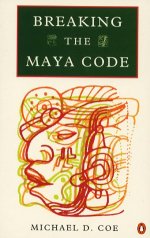
Breaking the Maya Code
Michael D. Coe
288 pages, including notes and index
published in 1992
Breaking the Maya Code is the story of how the Mayan script got decyphered. It is not as much a book about the language itself, as it is about the history of this decypherment. Until late in the 20th century, the general consensus was that the Mayans did not have a phonetic script and the hieroglyphics on the walls of their cities and buildings were assumed to be nothing more than an elaborate calendar. The Mayan script was a hodgepodge of ideaographs, signs that convey an idea directly and have no relationship with spoken language. Above all, Mayanists did not believe in a relationship with the Mayan languages spoken to this day in Mexico and Guatamala and the writing that appeared on the buildings of the Mayan ruins.
This was a view once also held of Egyptian writing, but that had changed in 1824, when the French linguist Jean-Francois Champollion realised first, that ancient spoken Egyptian must have been related to modern day Coptic and secondly, that it was possible to relate spoken Egyptian with hieroglyphics. Thanks to the famous Rosetta stone, there was an example of hieroglyphic writing which could be compared to a known language and before not too long the hieroglyphics were proved to be proper phonetic writing and could be read and thought. With large amounts of data available thanks to the scientists Napoleon took with him on his ill-fated Egyptian adventure, progress was rapid, once the principles of the hieroglyphics as a proper language were established.
The same thing happened with other ancient languages, but didn't happen with the Mayans writing until well into the 20th century and even now still lags behind. The reasons for why this should be are unclear. Though there were handicaps to decyphering the Mayan script, the most serious of which was the almost absolute lack of any extent Mayan books thanks to over zealous Spanish priests who ordered them burned, the study of other ancient languages suffered from the same handicaps and were cracked long before Mayan writing, which only started to be decyphered in the 1960ties and 1970ties.
Therefore, Breaking the Maya Code is continually looking for reasons why Mayan studies lagged behind their counterparts. Explicit or implicit, this question is never far away in Michael Coe's narrative. It is important to keep in mind that in unravelling this puzzle, he isn't an impartial witness, as he is a Mayanist himself and one of the earliest adherents to the theory of Mayan writing as a "proper" phonetic language. Not that he is unreliable, but it does colour his writing; one get the impression he was smacking his head at the missed opportunities written about in his book.
His closeness to the story he is writing about may be both a blessing and a curse. On the one hand, he is clearly very knowledgeable about this subject, on the other at some points he may be too close to the subject to see the whole picture. While he does give reasons for why Mayan studies lagged behind its Old World counterparts, e.g. the extraordinairy influence of certain conservative researchers, the disdain in which linguistics was held and the simple fact that being able to even speak Mayan was not considered to be important for a Mayanist, none of them seem to be the real reason. In fact, some, like the lack of knowledge of the Mayan languages by Mayanists, look more like symptoms rather than reasons.
It might be that there isn't a real reason for all of this, that the slowness with which Mayan writing has been deciphered was just contigent on the history of Mayan studies, that it was a combination of factors that happened to come out just wrong. The problem is, you don't know after reading Breaking the Maya Code, whether that is the case or not, because it gives these surface reasons, but doesn't look beyond it to the deeper underlying causes.
Apart from this singular failure however, Breaking the Maya Code is still an important book to read, because reading it makes you realise the search for knowledge isn't a smooth process, success isn't guaranteed and progress is not inevitable. Furthermore, it also put paid to the myth that scientific progress is the result of a few lonely geniuses, or at best, the result of a small team of scientists working in isolation. Breaking the Maya Code makes clear that it took the work of tens, if not hundreds of dedicated Mayanists to decipher Mayan writing.
The verdict then, is that this is both an excellent book to read if you want to know about how Mayan writing got decyphered and the history behind this, as well as a good look at how "science" operates. It is well written and engaging, though you will have to struggle through a lump of linguistic theory in the first chapter, essential to be able to enjoy the rest of the book, but somewhat of a chore nonetheless.
